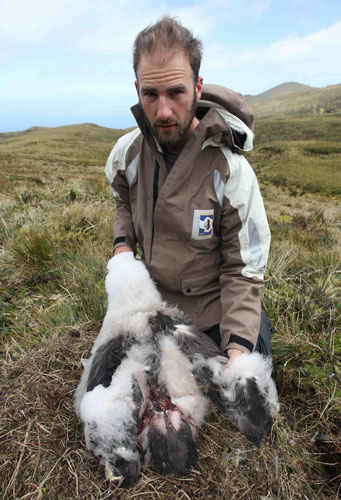"Islands are the epicenter of the current global extinction crisis and invasive vertebrates are the leading cause of extinction on islands. Removing invasive vertebrates from islands is a well-established tool to protect and restore island ecosystems and prevent extinctions."
ACAP-listed albatrosses, petrels and shearwaters breed, in the main, on islands. Many of these islands harbour introduced mammals, which directly or indirectly are causing havoc: think the "killer mice" and the Tristan Albatrosses Diomedea dabbenena of Gough Island, regularly featured in ACAP Latest News. Where to go to get an overview of efforts made or in progress to eradicate these invaders, or to search for a specific island or introduced animal?

Eaten alive!
Ron Ronconi holds a dying Tristan Albatross chick that was attacked by House Mice the night before on Gough Island
Photograph by Peter Ryan
The Database of Island Invasive Species Eradications compiles information on historical and current invasive vertebrate eradications on islands. Data from each project include information on the island, methods used in the eradication and contact information for people knowledgeable about the eradication.
The data base is hosted by the IUCN SSC Invasive Species Specialist Group (ISSG) and is supported by the NGO Island Conservation and the University of Auckland, New Zealand and by several other bodies. It contains information on 1182 eradications on 762 islands with a total area of 41 833 km².
To test the data base for islands that support ACAP-listed albatrosses, petrels and shearwaters I first searched for Australia's Macquarie Island and read that feral cats were eradicated in 2000, that eradication of rabbits is in progress and of rodents is awaiting confirmation, but that goats introduced in 1879 were eradicated by, among other methods, burrow fumigation - which I am sure is an error! Then I searched on the UK Overseas Territory of St Helena, Ascension and Tristan da Cunha but found Inaccessible Island in the Tristan Group is not listed, along with the successful eradication of its domestic pigs and goats. Lastly, I looked for South Africa's Marion Island and found information on the eradication of feral cats (Marion is still the World's largest island at 290 km² from which cats have been eradicated), altugh there seems to be some mix-up with aerial broadcast being listed as a primary baiting method. Actually baiting was done by injecting day-old chicks with poison and suspending them from rock overhangs out of the reach of House Mice. There was no broadcasting of poison bait.
So the data base is not perfect, but nevertheless is a useful source when assessing the state of play with protecting ACAP-listed species from vertebrate invaders. ACAP's own document on the subject was produced by Richard Phillips, Co-convenor of the Agreement's Population and Conservation Status Working Group.
Selected References:
Bester, M.N., Bloomer, J.P., van Aarde, R.J., Erasmus, B.H., van Rensburg, P.J.J., Skinner, J.D., Howell, P.G. & Naude, T.W. 2002. A review of the successful eradication of feral cats from sub-Antarctic Marion Island, Southern Indian Ocean. South African Journal of Wildlife Research 32: 65-73.
Phillips, R.A. n.d. Guidelines for Eradication of Introduced Mammals from Breeding Sites of ACAP-listed Seabirds. 9 pp.
Two other useful sources for published information on alien eradications on islands produced by the ISSG are the bulletin Aliens and the Global Invasives Species Database.
John Cooper, ACAP Information Officer, 11 November 2012

 English
English  Français
Français  Español
Español